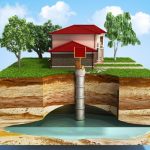In order to understand exactly how your water well works, it’s helpful to familiarize yourself with some of the most common water well terms. Below is a comprehensive list of terms that will help you understand the different components of your water well and how they all work together to ensure your water well and pump system is functioning properly.
Annular Seal: The annular seal, commonly made from bentonite and neat cement grout, is used to prevent surface water and other contaminants from entering your water well. It is placed between the borehole wall and the casing.
Aquifer: An aquifer yields usable amounts of water to your well. It is a channel that forms in sand and gravel, sandstone, or limestone.
Borehole: The borehole is the hole that is drilled to construct your water well. Usually, they are slightly larger than the well casing.
Casing: This is a steel or plastic piping that is placed around the borehole to prevent it from collapsing. Using the annular seal, the casing is sealed to the borehole near the land surface.
Drawdown: The drawdown is the difference between the pumping water level and the static water level. It begins when the water starts to pump and ends when it reaches a steady, or static, level. The amount of time taken to reach the static level is recorded as the drawdown.
Maximum Contaminant Level (MCL): The maximum contaminant level is the highest level of any contaminant that can be present in your drinking water without the risk of illness. The Environmental Protection Agency is responsible for setting the MCL for all water contaminants.
Maximum Demand: The maximum demand is the highest level of water usage that your home will require at any given time. This is crucial for determining the appropriate size of your water well and pump system.
pH: The pH (potential of hydrogen) level measures the acidity or alkalinity of your drinking water. The level ranges from 1 to 14, 7 being the neutral point. A pH level below 7 indicates acidity. The lower the number, the more acidic the water is.
Pressure Switch: The pressure switch connects to your electrical service line and supplies power to your well pump. The switch senses the water pressure level in your home and will turn the pressure off or on when needed.
Pumping Water Level: This is the distance from the water in your well to the land surface while it is pumping.
Septic Tank: Your septic tank contains all of the waste that comes from your home. It allows solids to settle before they are distributed to a leach field in order to be absorbed into the soil. They are used when your home does not have a sewer line that can transport waste to a treatment plant.
Static Water Level: This is the distance from the water in your well to the land surface when the well is not pumping.
Well Cap: The well cap is the top cover of your well. It is usually made of metal and fastens tightly to the top of your wellhead to prevent contamination.
Well Depth: This is the total depth of your well, measured from the land surface all the way down to the bottom of the well.
Yield: This is the amount of water that your well will supply to your home when pumped. It is measured in gallons per minute.
Understanding Your Water Well
While the list above does not cover every single water well term there is, it will provide you with a solid background of information to learn from. If you’re looking for more information, A1 Well Drilling & Pump Service can help. With four generations of experience, we have the knowledge and skills required to help you with all of your water well needs. We offer a variety of services including well drilling, well and pump service, water treatment installation and service as well as custom design and installation of various water well systems. If you’re in need of well drilling or pump services, contact us today!





